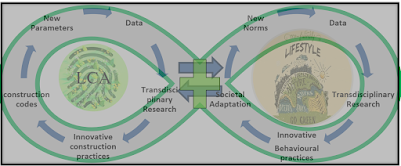Indigenous Engineering Solutions in Construction, Green Buildings and Sustainability
Historically, Governments have been deriving the construction Industry. In India CPWD a premier construction agency, also performs a regulatory function in setting the pace and programmes for the building industry1. As a part of Azadi Ka Amrit Mahotsava, a National Conference on "Indigenous Engineering Solutions in Construction of a self-Reliant India" was organised by the National CPWD Academy. Compendium of conference papers is now available on the National CPWD Academy's website. |
The paper "Indigenous Engineering Solutions in Construction, Green Buildings and Sustainability" was jointly presented. While I presented at the conference in person, coauthor Sh. Manoj Sharma joined remotely.
Unlike other conference authors who were masters of their calling, we had more questions than answers. It was not because it lacked hard work, in fact, the paper alludes to more diverse subjects and references than any other article. It is due to the uncertainties and threats that climate change presents and the scope of vast mitigative potential that buildings and the construction sector have.
The blog intends to find collaborative partners and opportune projects in finding answers to our questions and create knowledge to build back better. Solutions that could tangibly help in India's commitments to Intended Nationally Determined Contributions (INDCs) while keeping pace with our habitat-related developmental requirements. A narrative on what went well at the conference follows.
Despite the constraints of time and space, topics most pertinent to present needs were included. The contributions came from diverse backgrounds and expertise. The participation was extended to client departments. The event was supported by the top management. Agility, adaptability, and welcoming openness to change are very encouraging. On a personal note, paper preparations enabled meaningful collaborative efforts.
As India pushes hard to come out of the corona, professionals ought to come up with practical solutions to build better. Transformative change and Inclusive sustainability requires that the top-down efforts are capitalised by the bottom-up organic growth of innovations.
1Induction Material for C.P.W.D. @ https://cpwd.gov.in/WriteReadData/induction_material/72.pdf



This comment has been removed by the author.
ReplyDeleteIndigenous engineering solutions in construction, green buildings, and sustainability focus on leveraging local materials, traditional practices, and culturally relevant designs to create environmentally friendly and sustainable structures. Here are some key aspects:
Delete1. Use of Local Materials:
Sustainable Sourcing: Utilizing materials that are readily available in the local environment reduces transportation costs and environmental impact.
Cultural Relevance: Local materials often have historical significance and are culturally appropriate, enhancing community identity.
2. Traditional Building Techniques:
Passive Design: Employing traditional methods such as natural ventilation, earth shelters, and thermal mass to maintain comfortable indoor climates without relying heavily on mechanical systems.
Construction Methods: Techniques like adobe, rammed earth, and straw bale construction offer low-impact and energy-efficient building options.
3. Integration of Indigenous Knowledge:
Sustainable Practices: Indigenous knowledge systems often include sustainable land management practices that can inform modern construction techniques.
Ecosystem Considerations: Understanding local ecosystems helps in planning projects that minimize disruption to natural habitats.
4. Cultural Significance:
Design Sensitivity: Designing buildings that reflect local traditions, values, and lifestyles fosters community pride and acceptance.
Community Engagement: Involving local communities in the design and construction process ensures that solutions are relevant and beneficial.
5. Energy Efficiency:
Renewable Energy Sources: Integrating solar panels, wind turbines, and other renewable energy technologies aligned with local practices and needs.
Water Conservation: Utilizing rainwater harvesting, greywater systems, and indigenous landscaping techniques for sustainable water use.
6. Resilience and Adaptation:
Climate Adaptation: Designing buildings that can withstand local climate conditions, including extreme weather, through resilient construction methods.
Future-Proofing: Ensuring that buildings can adapt to changing environmental conditions and community needs over time.
Final Year Project Centers in Chennai
final year projects for computer science
IEEE projects for cse
The National Conference on "Indigenous Engineering Solutions in Construction of a self-Reliant India" was a welcome initiative, as it focused on innovation and change in mindsets, and addressed important topics such as disaster and green building paradigms. The paper "Indigenous Engineering Solutions in Construction, Green Buildings and Sustainability" presented at the conference aimed to find solutions that could help India meet its commitments to INDCs while keeping pace with developmental requirements. Despite constraints, the conference successfully included diverse contributions from various backgrounds, encouraging adaptability and openness to change. Can you please discuss the following topic "Industrial Construction Companies In Chennai" in your next blog.
ReplyDeleteThe article "Indigenous Engineering Solutions in India" by Ashutosh Pandey is a thought-provoking piece on the importance of indigenous engineering in India. It highlights how indigenous engineering solutions can be more effective and sustainable than imported solutions in the Indian context. The author's argument that local engineering solutions can not only solve local problems but also boost the economy is well-articulated and supported by examples. The article is a call to action for policymakers, engineers, and the general public to prioritize and invest in indigenous engineering. Overall, this is an insightful read for anyone interested in sustainable development and the role of engineering in it. I also remember that Best Building Contractors In Chennai also provides a professional service similar to this.
ReplyDelete